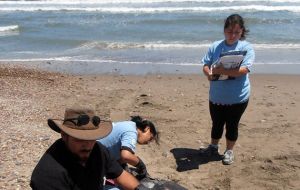MercoPress. South Atlantic News Agency
Despite Peruvian government report controversy over mysterious death of dolphins continues
 Environmentalists blame seismic surveying by oil companies and some experts mention toxic bloom
Environmentalists blame seismic surveying by oil companies and some experts mention toxic bloom The mystery surrounding the deaths of at least 877 dolphins in Peru deepened as the government said human activity was not to blame but failed to pinpoint a natural cause for the massive die-off.
A final report from the Peruvian government's Ocean Institute, which manages one of the world's richest marine ecosystems, said the dolphins did not die from a lack of food, hunting by fishermen, poison from pesticides, heavy metal contamination, an infection or a virus.
It also said there was no conclusive evidence that linked seismic offshore exploration by oil companies to the deaths of the long-beaked common dolphins along the Andean country's northern coast.
But it did leave open the possibility that abnormally warm surface water temperatures and high levels of algae may have played a role, saying further analysis would be needed to determine if any red and brown plankton species in the sea were toxic.
“The dolphins were killed by natural causes and not due to any human activity - that is what you might say is the major conclusion,” said Minister of Production Gladys Triveno, who oversees the government's Ocean Institute.
However, ORCA, a local NGO, says the deaths occurred after seismic events - which locals attribute to exploration by oil companies - damaged the ears of the sound-sensitive mammals and caused them to surface too rapidly.
“We found cells that had injuries due to bubbles that are associated with decompression sickness,” said Carlos Yaipén-Llanos, director of ORCA.
The government and many independent scientists say it is impossible to prove the bubbles were caused by decompression sickness, known by divers as the bends.
Houston-based BPZ Resources Inc has said it conducted seismic surveys starting on February 8 in part of the area but that it adheres to strict environmental standards and that the first deaths happened before it began exploration work.
Another company, Savia Peru, has said it was not working on its concessions in the area at the time of the deaths.
Both companies have said seismic exploration technology is used widely around the world and has never been linked to massive die-offs.
Large-scale dolphin deaths are relatively common globally and often go unexplained, though algae have at times been cited as a cause.
Between 1987 and 1988 as many as a thousand bottlenose dolphins died off the East Coast of the United States. Experts said the deaths occurred after the dolphins ate fish that had been contaminated by an algae rarely found in those waters.
Dolphins were not the only animal to have died in Peru's rich coastal waters in recent weeks. This month, warmer surface waters sent anchovies lower down into cooler waters where pelicans could not dive deep enough to reach them. Some 5,000 birds starved to death as a result.
The government says there is no link between the pelican and dolphin deaths.
Peru's northern coast is often hit by temperature oscillations between warm equatorial waters and the frigid Humboldt current the runs north from Chile. The Humboldt current is considered one of the world's most productive fisheries.
The region is in a transition phase from the La Niña to El Niño weather phenomenon that occur in the southeastern Pacific, said Bill Patzert, an oceanographer at NASA's Jet Propulsion Lab in California.
He said the warmer temperatures do not yet signal the arrival of El Niño, which has been linked to extreme weather globally. But he did say that warm surface waters often bring foreign plankton to coastal areas.
“When you see a massive die-off of bird species and marine mammals, often it's some kind of weird toxic bloom,” said Patzert.




Top Comments
Disclaimer & comment rulesCommenting for this story is now closed.
If you have a Facebook account, become a fan and comment on our Facebook Page!